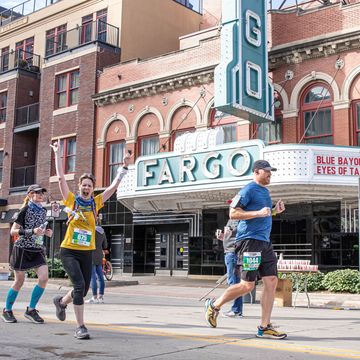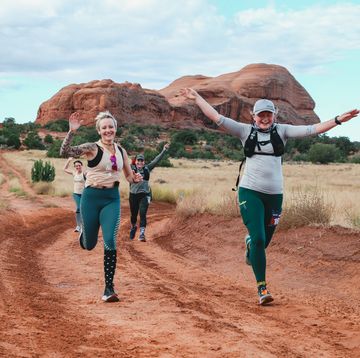You've trained, tapered, watched your diet and done your stretching.
But you show up on race day and feel slow and sluggish. If you're well-rested, shouldn't you feel better? For every athlete who doesn't cut back enough before a race, there are others who rest too much and lose the edge that had them feeling great during workouts.
The primary goal in the final two days before a race is to prime the body to perform at its peak level. This occurs when all the body's systems are functioning as efficiently and effectively as possible. The neuromuscular system is sending signals back and forth quickly between the muscles and brain, muscles are able to activate the maximum percentage of their fibers and fire them forcefully, and your heart is ready to pump oxygen-rich blood where it's needed.
In the days before a race, preparing the body to perform doesn't mean training to get stronger or faster. Gaining--or even maintaining--metabolic fitness (e.g., aerobic development or lactate threshold) is not important in the final 48 hours, because your body will not have time to adapt. Research has shown that the metabolic changes we gain with training stick around for some time.
In contrast, neuromuscular coordination can improve or deteriorate in less than a day. Optimizing the neuromuscular system--the communication vehicle between your brain and your muscles--requires constant stimulation because the growth and recovery cycle is very short. The best way to optimize running-specific neuromuscular communication is to run, especially at or near race pace. "The neuromuscular adaptations you make can result in more motor units [groups of muscle fibers and nerves] being recruited and a more economical use of all your motor units," says Jonathan Dugas, exercise physiologist, athlete and co-author of the blog Science of Sport.
TRAINING PLANS: Find a Runner’s World Half Marathon Plan to run your first, or fastest, 13.1.
Another priority in the final days is to increase blood flow to your muscles. When running, the blood vessels in your muscles dilate to allow more oxygen-rich blood to flow to them, just as a hose expands when water runs through it. In addition to oxygen, increased blood flow brings with it key nutrients, as well as hormones important for recovery, says Steve Magness, who coaches elite athletes and the University of Houston track team. Moreover, running causes your body temperature to rise slightly, helping the muscles become looser and more flexible.
These priorities highlight the need to keep running as you approach a race. But what should you do?
Ryan Warrenburg, assistant coach for ZAP Fitness, an elite training group in Blowing Rock, North Carolina, stresses the need to tailor your final days of preparation to your fitness level and individual response to training. Two days before a race, his experienced runners would typically do a short, easy run, finishing up with four to six strides of roughly 20 seconds at race pace. He'll have inexperienced runners, or those who run three days a week or less, take a rest day two days before a race.
Regardless of your experience level, if you're traveling to the race, especially if it's a long flight or drive, you'll need to do something to help your legs recover from the travel: either a short run, a light massage or a short walk. The goal this day is simply to make sure your legs feel fresh.
The final day before the race, run anywhere from 10 minutes to 50 percent of your normal easy-day volume and include some neuromuscular work. Strides or surges at race pace will help facilitate optimal neuromuscular coordination on race day. At minimum, do two or three 20-second strides at race pace. "More experienced runners can tinker with longer race-pace work with a long recovery," Warrenburg says. One option could be 4–6 × 200m repeats at race pace, with the last two a bit quicker, taking a 5-minute recovery jog between repeats.
Make sure you practice your strategy before a few key workouts during your training cycle. Athletes differ in what type of running makes them feel fresh and what workouts leave them drained or sore. Some prefer quick strides, others a bit more distance with some work at tempo or 5K pace. A shorter race requires you to move fast and efficiently from the gun, so you need to be fresher on race morning for a 5K than for a marathon, where you can work out any sluggishness during the early miles.
Don't do so much that you compromise your race, but you needn't fear a short workout the day before. "If your recovery runs during the hardest portion of your training cycle have enabled you to adequately recover between hard workouts, a short run is not going to fatigue you," says Scott Simmons, coach of the American Distance Project.
Elite Sharpening: Top runners seek a balance on the day before a race.
SARAH CROUCH, a 1:13 half marathoner and Olympic marathon trials qualifier, underscores the importance of experimenting with what works for you. Crouch performs a shakeout run of about 75 percent of her normal easy-day mileage two days prior to race day and then a shorter run with 2 x 1-minute and 2 × 30-second surges the day before to help her feel sharp.
"I've tried many different approaches in the last two days [before a race]. Too little running and I feel stale, too much and I don't have that certain 'pop' in my legs, so I try to balance those two during the last two days."
NEELY SPENCE GRACEY, who boasts a 15:27 5K PR and has run 32:16 for 10,000m, likes to do a non-timed, easy shakeout run (about 8 miles) two days before the race to help mitigate the impact of travel. The day before a race, she runs about 50 percent of her usual daily mileage (4–6 miles) with some light strides. Her main priority in the final two days is to relax and let her training do the racing for her.
"The biggest thing I have learned as a runner is that going with the flow and being flexible is a key component to success. There are so many things we cannot control, so it's all about handling the chaos of travel and the stress of competition using the least amount of energy."
, seventh-place finisher at the 2014 Boston Marathon in 2:11:47, focuses on reducing pre-race nerves and trying to get his legs to feel "snappy" in the final days before a race.
Arciniaga does a short run (for him, about 8 miles) two days before to shake out the travel while loosening his legs, and an easy run with four to six strides the day before to stimulate the neuromuscular system.
"I tend to stick to the philosophy that the 'money is in the bank,' and there is nothing I can do to gain fitness in the last week of training, so everything I do is meant to help my body feel as good as possible."














